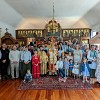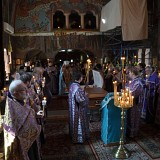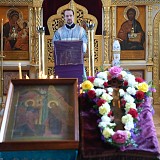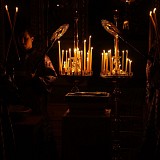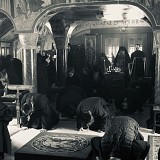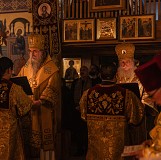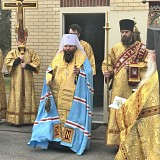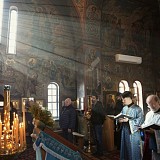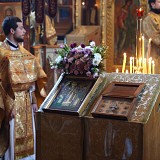Over two years ago our Abbot Bishop Luke was struck by the aura of spiritual antiquity and holiness reflected in the artifact, a stone head of an early Hieromartyr Benigne of Dijion France. After extensive research he decided to attempt to obtain a relic of the Saint for the Monastery. Correspondence began with the Archbishop of Dijon, Monseigneur Roland Minnerath, with the assistance of a parishioner at our Synod Cathedral Dr. Joachim Pissarro. Finally our priest in France, Père Quentin de Castelbajac, was able to receive the relic in Dijion from the hands of Archbishop Roland. Eventually, several months later (as this was during the pandemic) he was able to pass it on to Dr. Pissarro who was on a lecture tour in France.
On his return to America Dr. Pissarro brought the holy relic to the Monastery. Much labor was needed to create an icon wherein to enshrine the relic. Because the image would be one of its kind an iconographer the postulant Gabriela from our convent of “Quick to Hear“ worked together with Bishop Luke for more than six months and with God’s help the icon was completed. Through the prayers of the Hieromartyr Benigne (Benignus) may the Lord
bless all those who contributed to a revival of the veneration of an early Western Orthodox Saint.
Copies of the icon are available from our icon mounting studio.
The Origins of St. Benigne- translated by a monk at Jordanville
The origins of St. Benigne have been passed down to us through the centuries by tradition, such as his life and martyrdom, and as such there are many uncertainties about them. However, the stories all seem to come together and start with St. Polycarp of Smyrna (current day Izmir in Turkey) and disciple of St. John the Evangelist, founder, and head of the churches in Asia. One night, St. Polycarp had a vision: his student, Irenaeus of Lyons, was calling him to ask for help in the face of the desolation of the churches in Gaul, which were being horribly persecuted. Polycarp then sent three of his disciples to leave and announce the Gospel to the people of Gaul: the priests Andoche and Benigne, as well as the deacon Thyrse. History has retained that Benigne, the “Bien-Bon”, the benevolent, came from a Christian family in Ephesus (modern-day Selcuk), situated 50 km south of Smyrna. The architectural and spiritual richness of this city, where Benigne spent the first years of his life cannot but play a huge role in his destiny. Indeed, Ephesus, on the one hand, housed the Temple of Artemis, one of the Seven Wonders of the Ancient World, and, on the other hand, was the place of the Dormition of the Virgin. The places filled with history could not help but accompany the young Christian in his spiritual journey. Thus, in the middle of the second century of our era, in 152, Polycarp, going to visit the sovereign pontiff Saint Anicetus, would have accompanied these new apostles to Rome. The Holy Father showered them with blessings and encouraged their mission. Freshly blessed, the three young evangelizers left Rome and immediately embarked for Gaul. Their ship took them to Corsica where Andeolus, a new missionary, joined them. Continuing their maritime journey, all four arrived in Marseilles from where they left to go to Lyon, a city in which burst all the fury of the persecution against Christians ordered by Emperor Severus. They received the hospitality of the priest Zacharius, at whose house an angel came to reveal to Andeolus his mission in Carpentras. As for Benigne, Andoche, and Thyrse, they advanced towards the north, taking the great Roman road which led to the estuary of the Seine: the via Agrippa. Thus they arrived at Autun, the city of the Aedui. A senator from the city, Fauste, an adorer of Jesus in secret, would have opened the doors of his palace to them and would have received them as the envoys of Heaven.
He whom tradition presents as the apostle of Burgundy, therefore, belongs to this famous Greek mission of Asia Minor, whose ranks include the two illustrious founders of the Church of Lyon: Saint Pothin and Saint Irenee. But why did these first preachers of the Gospel arrive in these places of Gaul? To understand it well, you have to represent yourself in the context of the time of this distant country for an inhabitant of Asia Minor. The three main cities were Marseilles, Lyons, and Autun. The origin of the development of these cities makes it possible to understand the propagation of the Gospel in Gaul and more particularly in Burgundy.
At the beginning of our era, Marseilles was a free state. It is the most illustrious and oldest colony founded by the Greeks; it enjoys an extraordinary reputation despite its isolation and remains an ever-rejuvenated center of Hellenic culture. Lyon is a relatively young city. Caesar transformed it from top to bottom, transforming it from a simple border oppidum into a common capital of the provinces of Aquitaine, Celtic, and Belgium. It is the “Acropolis" erected by the Romans in the center of Gaul. Autun, of more recent creation - 12 BC - is a Gallic Rome established in the center of the Aedui country, the first and only city in all of the Celtic province to have deserved the title "friend" of the Roman people.
The first preachers from Asia Minor, therefore, did not feel too out of place: Marseilles, a Greek-speaking trading city, was home to a large number of Orientals. In Lyon, the Italian colonists were also strongly mixed with the Greeks and the Levantines. There even seemed to be many Jews there, who were easier to convert than the pagans. In Autun, we encounter many Greek merchants who knew how to take advantage of the trade routes that led there and of the wealth of this city. In addition, there were many renowned schools run by Greeks. This city still conceals many treasures today, such as the prayer of Pectorios, engraved on a marble tablet, found in a cemetery, and considered as one of the oldest traces of Christianity in Gaul. This stone is marked with a text in Greek letters, written around the year 200, and consists of an acrostic forming the word "ICHTYS", the divine Fish meaning "Jesus Christ, Son of God Savior."
The first apostles of Burgundy thus followed in the footsteps of their eastern compatriots who had paved the way for them. Everywhere else, as soon as one deviates from the main strategic paths, the foreigner is encountered only in exceptional circumstances. At first, Christianity had to be introduced into the Burgundian lands, or neighboring lands, during the second century, thanks to isolated individuals, led to settle among the Aedui or among the Lingones to exercise their trade. This explains the exotic character of the names that have come down to us. Then the second stage sees the arrival of the fugitives from Lyon, persecuted Christians who reach the countries of the North to hide and preach. Finally, the missionaries themselves will intervene, charged by the religious authority with developing a Christian Church, which is still rudimentary. Benigne and his two companions took part in this last movement, which made it possible to extend Christianity to the two most illustrious peoples of Gaul: the Aedui and the Lingones.
The Baptism of St. Symphorian
Tradition establishes the initial acts of evangelization from Benigne to Autun, the first important stage of his journey. Fauste and his wife Augusta, important citizens of Autun, had a son Symphorian. Benigne, assisted by his companions Andoche and Thyrse, baptized the child, aged three. Until revolutionary vandals destroyed it, a statue of the event, dating from High Antiquity, was on display in the current Saint-Benigne cathedral in Dijon. It is the subject of a precise description by the authors of the "Voyage litteraire des Benedicitins" (volume 1, p. 142). This text teaches us the way in which baptism was once given: Symphorian is represented in a baptismal font, stripped of his clothes to the waist. On the edges of the tank, there is a cloth that apparently was there to cover the child when leaving the sacred pool. Next to it, Benigne, dressed in his priestly vestments as if to say mass, holds an ewer from which he pours the water on the child. He is assisted by another priest, Andoche, dressed like him and showing a tonsure haircut, like most religious men of the time.
Notwithstanding the obstacles which presented themselves to them, Benigne, Andoche and Thyrse transmitted their faith to the Aedui with indefatigable eagerness. In a few years, a fervent Church was formed in Autun. At Fauste's request, Benigne would have given it to his two companions and would have left for Langres where Fauste's sister, Leonille, lived. She had three sons, educated, distinguished, and pagan like their father. Fauste entrusted Benigne with the mission of converting them. In 164, Benigne, with two other disciples, left Autun for Macon, where he left his traveling companions, then went to Langres by one of the routes along the Rhine.
As for Symphorien, he was one of the first martyrs of Burgundy, he was beheaded for the crime of impiety towards the official religion, by making fun of the processions that were made in honor of the goddess Cybele for the prosperity of harvests and vines. The spread of his cult from the Merovingian period is an indication of the authenticity of his torture and also of the importance of the Church of Autun in Gaul, a Church whose influence was considerable for many centuries. In the middle of the 5th century, the priest Euphrone, who became bishop of Autun, built an abbey destined for great renown, on the site of the oratory containing the relics of Saint Symphorien.
The fate of Andoche and Thyrse was no more lenient than that of Symphorien: they were martyred at Saulieu. An underground crypt collected their remains. On this crypt was to be built a few centuries later the Basilica of Saint-Andoche, a marvel of Romanesque art.
The Baptism of the Three Twins
Tradition tells us that once having arrived in Langres, the capital of Lingons, an important group of people in Gaule, Benigne was welcomed with great joy by Leonille. Leonille presented him with Twin brothers, the term triplets did not exist in that time period, Speusippe, Eleusippe, and Meleusippe who were twenty years old. They had lost their mother at a very young age, and their father, a pagan, had given them a solid upbringing. Benigne met them in their home in Balesme, a few kilometers south of Langres. In their home, they habitually sacrificed, according to the common practice, to the goddess Nemesis. In their splendid home, they had erected 12 altars in honor of the gods, causing great pain to their grandmother Leonille who tried to explain to them the Christian religion, as she did with her brother Fauste, but unsuccessfully.
In the popular imagination handed down over the centuries, Benigne is said to have conquered these young men. They built the first fruits of the Church of Langres and were, for Benigne, zealous auxiliaries who spared nothing to assist him in his mission.
Also, in a fairly short time, there was formed in Langres, a nucleus of neophytes who were to constitute the solid foundations of a great Church. After having contributed to ruining paganism in the heart of Lingon country and having raised the cross there, knowing that the three brothers would be worthy and active representatives of his mission, Benigne resumed his journey towards Dijon. The Three Twins, active preachers of the Gospel, affirmed their faith, and publicly showed their contempt for the gods they once worshiped. Immediately the people rose up, excited by the patricians. Pursued, the siblings were quickly arrested. Legend has it that their martyrdom took place on the Roman road that led from Langres to Lyon. As they were thrown bound hand and foot into a great pyre, Jesus appeared to them, broke their chains and the holy martyrs sang his praises.
They surrendered their souls to the Saviour. The pagans found no trace of fire on their bodies. The three brothers were buried not far from there, two miles south of Langres, at the intersection of two Roman roads: the one that led to Lyons and the one that went in the direction of Autun.
Despite the persecution that continued to rage, the faithful flocked to pray at the tomb of the Saint Twins. A few centuries later, a primitive Romanesque crypt was erected around the tomb. This semi-buried chapel constitutes the foundations of the Church of Saints-Geosmes and still, today hosts a group of sculptures, where Benigne is represented standing, near the baptismal font, arms extended like those of a man in prayer. : the Three Twins come forward to receive baptism. The first seems to knock on the door to indicate that he is asking for grace. Over the years, the crowds flocked; the Three Twins were venerated. The Church of Langres continued its rise, its bishopric was one of the most powerful in France. As such, at the center of an immense diocese, the bishop of Langres, third duke, and ecclesiastical peer, had the particular privilege of carrying the scepter given to each new King of France at his coronation.
Evangelization of Dijon and martyrdom of Saint Benigne
According to the acts that have been found, his mission of evangelization of the Lingon people accomplished, Benigne resumed his journey, in a southerly direction this time, to go to Dijon. Built on the banks of the Suzon, this city, although not very important, enjoys a certain reputation. Benigne made proselytes there discreetly and for twenty years, without arousing umbrage among the pagans. Those to whom he preached, touched by the doctrine which the apostle preached to them and struck by the purity of his life, renounced sacrilegious worship and claimed baptism with ardor.
To reunite the people of Dijon, Benigne blessed two underground oratories: One dedicated to Saint John the Baptist and Saint John the Evangelist - on which the church of Saint-Jean would be built a few centuries later -, the other to Saint Etienne, inside the castrum or fort within the city walls. The latter, over time, became the church and then the Saint Etienne cathedral, now disused.
As soon as he arrived in Dijon, Benigne was helped by a virgin, named Paschasie, who embraced the preachings of the evangelizer with fervor and paid him the homage of her life. Paschasia helped the priest to spread the faith: she put her house and her goods at the service of the apostle. She provided for his needs, prepared souls to hear him, and watched to ward off the suspicions of pagan magistrates. She paid for this devotion with the palms of martyrdom.
When Benigne thought he was being watched, he retired to the crypt where the Abbey of Saint-Etienne would later stand and there he catechized. Sometimes he changed location and went to evangelize neighboring towns and villages.
Alas, the fame of Benigne betrays him. The conversions he had carried out in Dijon, after those of Autun and Langres, aroused the suspicions of the prefect Terentius, in charge in particular of protecting the pagan cult. The emperor was able to admire a nascent city embellished with temples dedicated to Jupiter, Saturn, and Mercury. He then recommended not to suffer any Christians in the city. Terentius was aware of the presence of a stranger: “We don’t know if he is a Christian, Ternetius told the emperor, but there is a man here with a shaved head who doesn't follow our traditions. He rejects our religion; he washes our people with water and anoints them with oil. He also has made many followers. He preaches about another god, and in his name, he promises those who believe eternal life.” “From what I have heard, concludes Marcus Aurelius, this man is, therefore, a Christian. Find him and bring him to me bound.
After a short period of calm, the persecution against the Christians reignited. Therefore in 178, the edicts of Marcus Aurelius sought to seek out and punish based on religious beliefs.”Put to death the confessors of Christ.” Everywhere, those who held the Christian faith were herded like dumb beasts and without distinction of sex, age, or health were subject to the cruelest tortures. The martyrs made during this persecution were so numerous that their blood-stained crimson the amphitheaters of Rome, Smyrna, and in Gaule. Amongst them were Saint Andoche, saint Thyrse, and the three Twins.
Thus, Saint Benigne, chased by Roman soldiers, was forced to flee. The priest fled headlong out of Dijon and hid for a while at Prenois, two leagues to the west, in the midst of a hollow that can be seen to this day. Then he took refuge in Epagny on the road to Langres, two and a half leagues north of the castrum (fort). Chased by the soldiers of Terentius, he was finally stopped close to a spring that has always been known as the spring of Saint Benigne, An old tradition accuses the inhabitants of Larrey of having betrayed the fleeing priest. A popular song native to the village of Prenois describes this flight.
Legend has it that Benigne, bound in chains, was brought before Marcus Aurelius who asked him to abandon his religion in exchange for an honored position in his palace. The saint refused to apostatize, and the Romans ordered that he be beaten with beef tendons. This was carried out with such hatred and cruelty that his flesh was ripped off in strips and his entrails were exposed in many places. Despite these terrors, Benigne never ceased praying. As night fell, he was thrown into the dungeon of a dark tower. An angel filled this place with an aroma of ambrosia as he tended to the wounds of the martyr.
The next morning, Marcus Aurelius, hearing of this miracle wanted to attribute it to his gods and ordered that Benigne be forced to eat the burnt offering of the pagans. His prayers of supplication and the sign of the cross made the pagan idols and the vessels containing the sacrifice disappear, even the meat vanished into thin air. Marcus Aurelius, furious at this, had brought to the prison a large hollowed-out rock and had it filled with molten lead, into which he plunged the feet of Saint Benigne. At the same time, they drove red hot pokers into his hands and fingers. Despite all these sufferings, the Christian continued to preach to his executioners, exhorting the soldiers & tribunes to believe in Jesus Christ.
The martyr was then locked in the dungeon for six days without food, with twelve furious and starving dogs who should have devoured him and gotten rid of his body. However, the angel returned, illuminating the cell and delivered Benigne from his suffering, and gave him the heavenly bread to eat, all the while calming the dogs' ferocity. On the sixth day, when they opened his cell, the saint was found safe & sound and singing praises to the Lord.
Irritated, Marcus Aurelius ordered that the guards beat the head of the prisoner with an iron bar and that he be put to death with jabs from lances. This was done with such ferocity and rage that the lances crossed in the bowels of the shepherd. Loyal followers assembled outside the prison to attest and give witness to the courage and the triumph of the saintly apostle. It was on the 1st of November 178, under the pontificate of St. Eleutherius.
Tradition has it that this dungeon is with a tower, in the castrum (fort) in the garden of the Hotel Fyot de Mimeure, actually 23 rue Amiral Roussin. A spiral staircase leads down to the redoubt located at the bottom. For a long time, the place has been known as Petit-Saint-Benigne. This tower is visible today at 11 de la rue Charrue.
|
| |||||||||||
